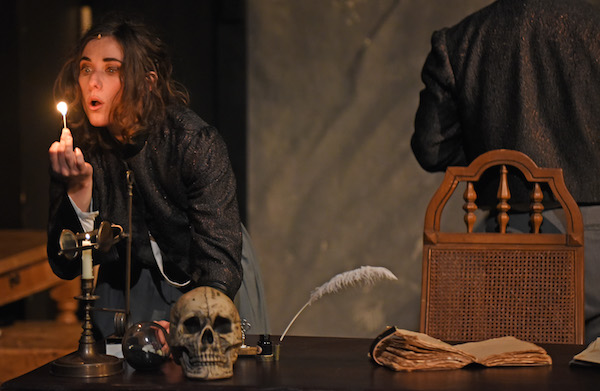The current production of Frankenstein at the Wallis Center for the Performing Arts pushes the envelope. Whether that’s a good thing is open to interpretation. It’s an unusual mélange of bone-crunching mayhem performed by an ensemble of 12 actors and musicians tasked with bringing the Mary Shelley classic back to life. The Wallis commissioned the project in partnership with Four Larks, a Los Angeles-based enterprise known for site specific performance art, fusing theater with orchestration and choreography. The work, described as “an exuberant amalgamation of dynamic physical theater, live music and experiential design,” draws from the original text of Mary Shelley’s 19th century novel by going back to the source material to deconstruct the classic tale. The result is something of a mixed bag depending on one’s appetite for experimental theater.

To be honest, I struggled with how to review this work. I didn’t want to pan it because I’m a firm believer that theater needs to take risks in order to stay vital and fresh. Theater isn’t always readily accessible or even, I daresay it, entertaining. Sometimes it makes you squirm in your seat and look for the exits. I went into Frankenstein with an open mind and high hopes. I took my seat in the intimate Lovelace Studio Theater and soaked in the ambience of the wonderfully decorated set made to look like the quintessential laboratory of a mad scientist while harpsichord music played as the audience settled in. The program notes mentioned there would be partial nudity and strobe lighting, both of which I was on board for. As the play began, it did feel special and eccentric in a kind of Tim Burton-esque way. Other aspects just felt weird for the sake of being weird. Like when some of the characters used lip retractors for no apparent reason. The creators incorporated Mary Shelley into the mix, as a narrator, which I thought was a clever addition. Claire Woolner brought an engaging quality to the role, resembling Winona Ryder in her heyday.
The characters spoke in a stilted antiquated manner which felt archaic. I accepted this conceit in keeping with the historical origins, but after a while, it grew tedious and got in the way of the storytelling. One sequence which felt particularly awkward (maybe that was the point) was where the monster (performed by Max Baumgarten) voyeuristically watches a family going about their daily routine from a distance. We hear his thoughts, spoken by the author (Mary Shelley). But the family’s interactions are intoned vocally with no actual words. I suppose this was to convey the notion that from the monster’s perspective, he didn’t understand the language they were speaking. It felt like an exercise you might see in a beginning drama class.

As the play continued, it became increasingly scattershot and aimless. Even at a rather lean hour and fifteen minute running time, I found myself hoping for it all to end. It didn’t help matters that the performance I saw was interrupted due to a technical issue, forcing the actors to leave the stage. By this point, the play felt so strange, I thought perhaps this was part of the show. But it wasn’t. Apparently, the theatrical haze triggered a smoke alarm. The interruption served as an unscheduled intermission, providing an opportunity for some audience members to use the restroom while others checked their Apple watches for messages. Once the all-clear was given, the actors reclaimed their positions and the play resumed. Assuming there’s no need for spoiler alerts, I’ll just say that the show reached its logical conclusion as the creature unleashed its revenge for not being able to receive the love and attention it craved. While I admire the effort and inventive spirit, this reworking of Frankenstein felt pretentious and a little too precious for its own good. To be fair, there was one particularly memorable sequence involving the creation of a mate for the monster. Joanna Lynn-Jacobs (as Elizabeth Lavenza) fully embraces the bizarre-surreal paradigm as she undergoes an electrifying and arresting transformation which has her vocalizing manically in an operatic manner as projected images flash across her torso.
Like any abstract piece of art, theater can be seen as a sort of Rorschach test. We project onto it things that may be on our own mind. As for me, I couldn’t help seeing Donald Trump as the monster that we created. Our collective fixation on reality TV, celebrity and the backlash against Obama-era woke-ness has unleashed a revenge of the MAGA, the likes of which this country has never seen. Of course, it’s not just an American phenomenon. The rise of fascism has been rippling across the Pond and around the world. It’s a disturbing thought that we share some culpability even as we try to disown Trump as an aberration. As much as we’d prefer to cast him as anathema to everything this country stands for, we created the conditions for his rise. The central question at the heart of Frankenstein is twofold: How do we account for our own complicity in the creation of the monster? And once the monster has been unleashed on humanity, can the damage be contained or reversed? It seems we’re on the precipice of finding out.
Photo credits: Kevin Parry
